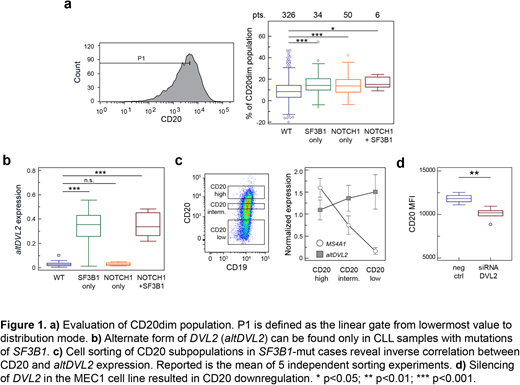Abstract
Background
Chronic lymphocytic leukemia (CLL) is characterized by a CD20 expression lower than other lymphoproliferative disorders, hampering treatment efficacy of anti-CD20 antibodies. Although most mechanisms behind this phenomenon are still obscure, we demonstrated that mutations of NOTCH1 associate with a lower CD20 expression, ascribed to a NOTCH1 mutation-driven repression of CD20 transcription by hystone deacetylases (Pozzo et al. Leukemia 2016). This may explain the association between NOTCH1 mutations and clinical resistance to anti-CD20 immunotherapy in CLL patients treated with FCR (Stilgenbauer et al. Blood 2014).
SF3B1 mutations affect ~10% CLL cases at diagnosis; a recent characterization of their functional meaning highlighted transcriptome-wide alterations of splicing patterns affecting several pathways, including the NOTCH1 pathway (Wang et al. Cancer Cell 2016). In this context, one of the most aberrantly-spliced genes is DVL2, a key component of the Wnt pathway and negative regulator of the NOTCH1 pathway.
Aim
To investigate CD20 expression in SF3B1-mutated CLL and the correlation with a putative secondary activation of the NOTCH1 pathway through splicing alterations of the NOTCH1 negative regulator DVL2.
Methods
Mutational status of NOTCH1 and SF3B1 was evaluated by next generation sequencing. Mutations with VAF-variant allele frequency below 2% were discarded. CD20 expression was evaluated by flow cytometry on the CD19+5+ population. Percentage of low-CD20 expressing (CD20dim) population was defined as %P1-(100-%P1), P1 being a linear gate spanning from zero to CD20 mode. Transcript levels of MS4A1 (encoding for CD20 protein) and spliced DVL2 were evaluated by QRT-PCR in cases with at least 75% of CD19+5+ cells. Statistical analyses were performed using Mann-Whitney rank-test.
Results
In a cohort of 537 unselected CLL cases, 93 cases (17.3%) carried NOTCH1 mutations: 62 delCT, 20 other truncating, 11 3′UTR (VAF range 3-84%, mean 32%; NOTCH1-mut); 46 cases carried SF3B1 mutations (8.5%, VAF range 5-53%, mean 32%; SF3B1-mut), the hotspot surrounding K700 being the most frequent (50%) followed by the hotspot surrounding G742 (30%); 7 cases (1,3%) carried both NOTCH1 and SF3B1 mutations. As trisomy 12 CLL is characterized by increased expression of CD20 and mutation of SF3B1 co-occurred in only 5/121 cases, the trisomy 12 subset was excluded from further analyses. Confirming previous findings, NOTCH1-mut cases were characterized by a lower CD20 mean fluorescence intensity (MFI) compared to WT cases (p=0.0154). In agreement with the hypothesis of a more active NOTCH1 pathway, CD20 expression was found diminished also in those cases carrying SF3B1 mutations, compared to WT cases (p=0.0059).
Since CD20 expression is highly variable between cases, spanning a 2/3-log range of fluorescence intensity, we evaluated the percentage of the CD20dim population, this quantity being independent from the actual MFI. This analysis confirmed that CLL cases with NOTCH1 or SF3B1 mutations show a greater proportion of CD20dim cells (NOTCH1-mut p<0.001, SF3B1-mut p<0.001, NOTCH1+SF3B1-mut p=0.0266; Figure 1a). Consistently, CD20 transcript expression was lower in both NOTCH1-mut (p=0.0021) and SF3B1-mut (p=0.0197) cases.
Presence of the alternatively spliced isoform of DVL2 (altDVL2) was identified only in those CLL cases with SF3B1 mutations (p<0.001), including the few cases bearing also NOTCH1 mutations (6 cases; Figure 1b). We performed cell sorting experiments on clonal SF3B1-mut cases (VAF>35%) to isolate CD20high and CD20low populations. MS4A1 expression (higher in the CD20high subset) inversely correlated with altDVL2 expression (Figure 1c).
As DVL2 can act as negative regulator of NOTCH1, we followed the hypothesis that loss of WT DVL2 due to alternative splicing may result in a more active NOTCH1 pathway. To simulate loss of DVL2 in the SF3B1-wild type CLL-like MEC1 cell line, cells were trasfected with siRNA for DVL2 itself and screened for CD20 expression. After 24 hours from transfection, CD20 expression was found downregulated at both protein (p=0.0062; Figure 1d) and transcript (p=0.0129) level.
Conclusions
In addition to NOTCH1-mut cases, also CLL cases bearing SF3B1 mutations are characterized by a lower CD20 expression, allegedly through a more active NOTCH1 pathway, potentially resulting in clinical resistance to anti-CD20 monoclonal antibodies.
Zaja:Amgen: Honoraria; Celgene: Honoraria, Research Funding; Novartis: Honoraria, Research Funding; Janssen: Honoraria; Takeda: Honoraria; Sandoz: Honoraria; Abbvie: Honoraria.
Author notes
Asterisk with author names denotes non-ASH members.


This feature is available to Subscribers Only
Sign In or Create an Account Close Modal